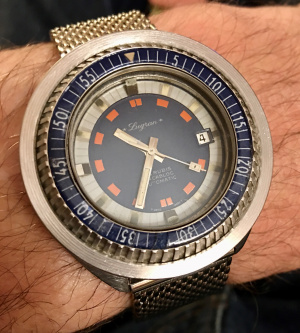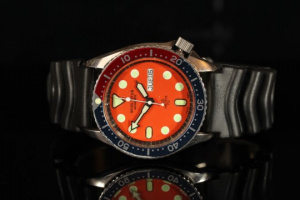Diving Watches: Difference between revisions
CambridgeV8 (talk | contribs) |
|||
| (One intermediate revision by one other user not shown) | |||
| Line 11: | Line 11: | ||
Good dive watches usually use some type of luminous paint on the dial and hands for low-light legibility. The dial may be orange to enhance readability. Early examples used radioactive radium (up to circa 1961) or tritium (up to circa 1997) paint, whose brown or yellowish decay is much prized by collectors. | Good dive watches usually use some type of luminous paint on the dial and hands for low-light legibility. The dial may be orange to enhance readability. Early examples used radioactive radium (up to circa 1961) or tritium (up to circa 1997) paint, whose brown or yellowish decay is much prized by collectors. | ||
[[File:Experts-Watches-Omega-Ploprof-SeaMaster-600-Diving-70.jpg|right|frameless|Omega Ploprof SeaMaster 600]] | |||
Many modern "professional grade" dive watches such as The Omega [[Seamaster 300]] feature helium escape valves — another safety measure designed to protect the watch from damage when going from prolonged periods in helium-saturation to the surface (something very few outside highly specialized commercial diving fields ever experience). | Many modern "professional grade" dive watches such as The Omega [[Seamaster 300]] feature helium escape valves — another safety measure designed to protect the watch from damage when going from prolonged periods in helium-saturation to the surface (something very few outside highly specialized commercial diving fields ever experience). | ||
| Line 25: | Line 27: | ||
==Links== | ==Links== | ||
* [[Switzerland]] | * [[Switzerland]] | ||
* [[Main Page]] | * [[Main Page]] | ||
Latest revision as of 01:40, 5 December 2024
A Brief History of Diving Watches

“More people have walked on the moon than have been to the deepest place in the ocean.”
The ability to read and measure elapsed time underwater is crucial, and potentially life-saving. The challenge of making a watch work underwater was great, one that the brightest and best in the watch world rose to and produced some of the most interesting, valuable and collectable underwater time-keepers...of all time.
A dive watch is one with 200 meters of water resistance. This is achieved through extremely tight machining tolerances, specially sealed points in the caseback and crown, and exclusive features tailored towards keeping a diver safe underwater. The terms compressor, super-compressor and respirator may be used.
A dive watch bezel is designed to act as a "dive timer," and its uni-directional rotation is engineered as an added safety measure — should the bezel get bumped or accidentally rotated, it will show that 'more' dive time has elapsed, thereby alerting the diver to ascend early and within the limits of his air supply.
Good dive watches usually use some type of luminous paint on the dial and hands for low-light legibility. The dial may be orange to enhance readability. Early examples used radioactive radium (up to circa 1961) or tritium (up to circa 1997) paint, whose brown or yellowish decay is much prized by collectors.

Many modern "professional grade" dive watches such as The Omega Seamaster 300 feature helium escape valves — another safety measure designed to protect the watch from damage when going from prolonged periods in helium-saturation to the surface (something very few outside highly specialized commercial diving fields ever experience).
The deepest a watch has ever been was to 11,000 meters in 2012 when a specially-built Rolex was strapped to the robotic claw of a submersible piloted by James Cameron, and driven to Challenger Deep in the Mariana Trench.

**UPDATE** In 2019, three specially made experimental watches dubbed Omega Seamaster Planet Ocean Ultra Deep Professionals survived a 10,928 meter dive to the bottom of the Mariana Trench affixed to the bathyscaphe Limiting Factor, setting a new world record as deepest dive watch by 12 meters!
